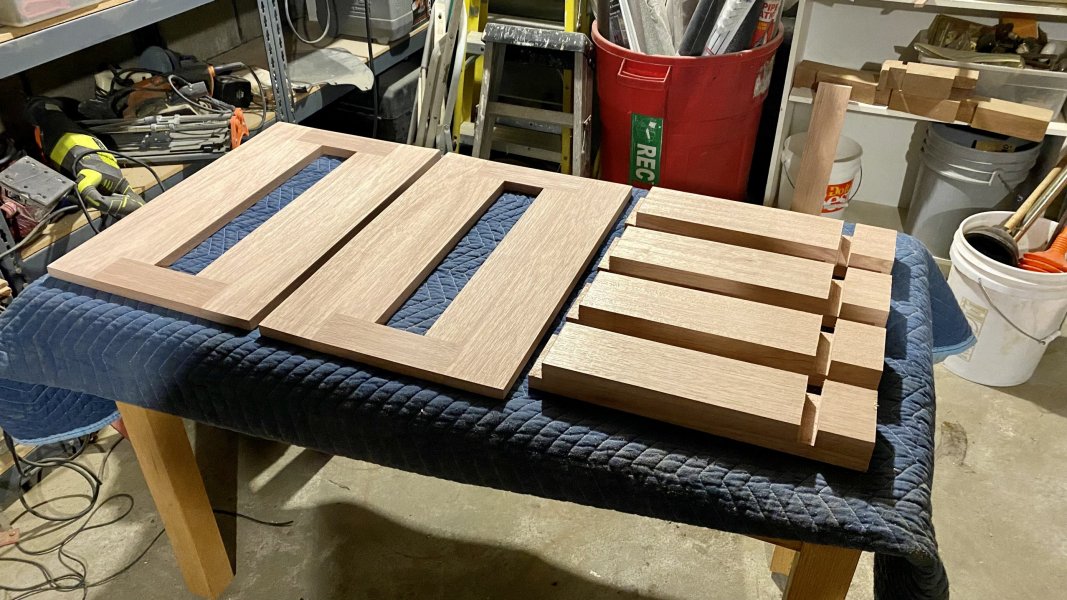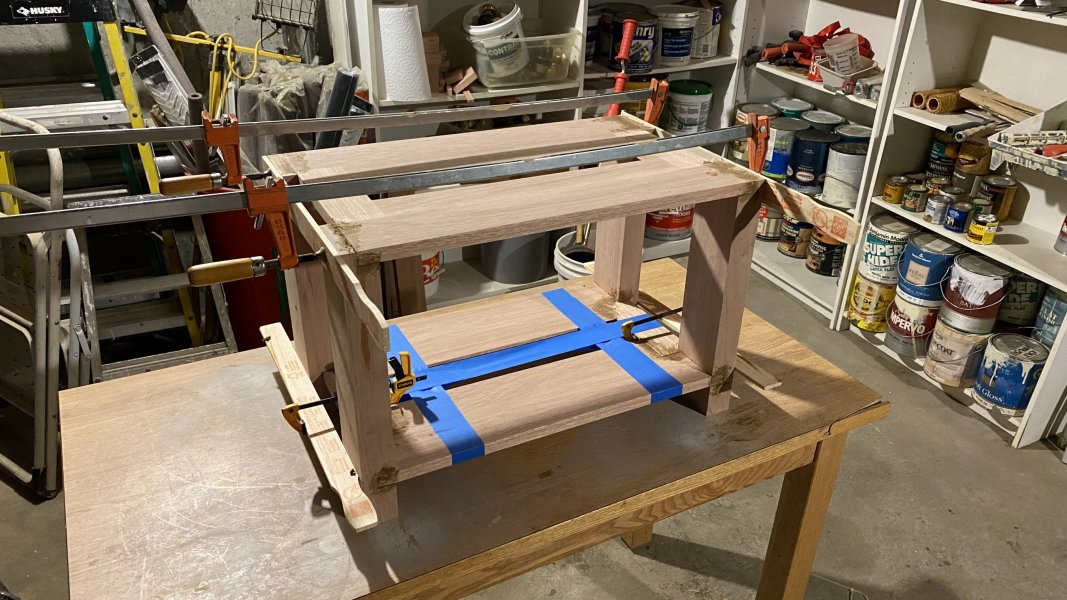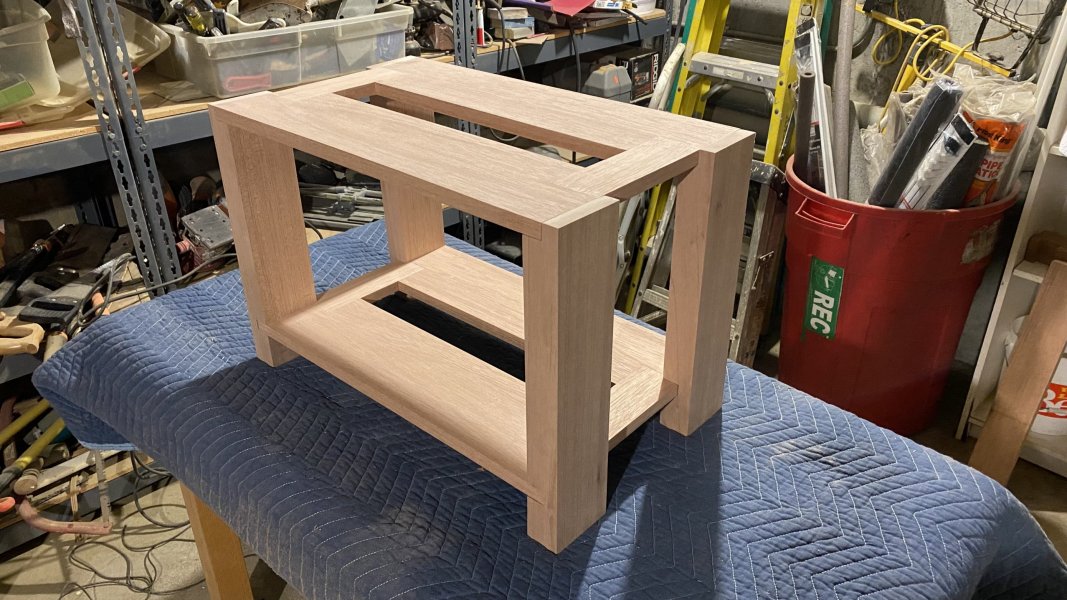Natural Sound
- Thread starter PeterA
- Start date
You are using an out of date browser. It may not display this or other websites correctly.
You should upgrade or use an alternative browser.
You should upgrade or use an alternative browser.
FWIW dept.:Thanks Everyone. I understand the issue was solved years ago. Can me move on from that discussion now?
If what you say just above is correct, it suggests that you might want to look into this. If they are not installed, its easy for any tech to add them without messing with the amp otherwise.As I understand it, Vladimir Lamm felt the sudden rush of electricity stressed the components and the tubes more than simply leaving them on all the time. He kept his gear on all the time.
I have designed and begun to build the supplementary rack for the power supplies for the new phonostage. It is a mahogany framework to support two steel plates, one under each supply. It will be on lockable rollers so that I can move it into place. The narrow end will be facing forward to expose the side of the component.






Lamm electronics are similar. From my M1.2 review at TAB:
Each amplifier uses a biasing circuit designed to achieve the thermal stability of its output transistors and other components. Further evidence of quality is the attention paid to boot time -- perhaps the most precarious moments for any high-powered amplifier. The M1.2 features a soft-start protection circuit where filter capacitors do not receive initial voltage for 2.5 seconds after turn on; then time relays initiate, delaying readiness for one minute to allow warm-up. If internal tests find an issue, the amp turns off and waits; if the issue resolves itself, it turns back on.
The Lamm M1.2 is an hybrid amplifier, having a solid state section and tube components, that have very different warm-up times - tubes are non conductive until the filament get hot and in this condition plate voltages can be very high and vary significantly during warm. It can't be compared with pure tube amplifiers. The 240 second Siegfried II warm up sequence is much more complex than this one - it also checks tubes condition and bias.
Last edited:
As I understand it, Vladimir Lamm felt the sudden rush of electricity stressed the components and the tubes more than simply leaving them on all the time. He kept his gear on all the time.
Now that it is getting warmer and I do not have air-conditioning, I may turn my gear on/off once a day when listening to keep the room cooler and reassess next winter.
Peter,
I think you are misreading Vladimir Lamm manuals. They just refer to the soft-start circuit avoids the inrush mains current peak, inoffensive to the amplifier but that can be a problem with some poor mains supplies or generate noise or trigger functions in other equipment that is switched on. He also says that the inbuilt delay in applying HV extends tube life, avoiding the effect you claim. It would be ridiculous if a manufacturer of high quality high price electronics could not avoid the effects of switching on and off equipment normally.
Cognatulations - they look great. Are you cutting and building them yourself?I have designed and begun to build the supplementary rack for the power supplies for the new phonostage. It is a mahogany framework to support two steel plates, one under each supply. It will be on lockable rollers so that I can move it into place. The narrow end will be facing forward to expose the side of the component.
View attachment 109743
View attachment 109744
View attachment 109745
Cognatulations - they look great. Are you cutting and building them yourself?
Thank you. Yes I’m doing the whole project myself. It was a challenge because I can’t figure out how to hide the power supplies in my living room which is already overrun by too many black boxes. Sound trumps aesthetics.
Sudden in-rush is a real problem, especially in big, high-power tube amps. For my old MB-750s VTL developed outboard, in-line "soft-start" boxes.
No, they were not "soft-start" boxes. They were just the common type of rush limiters incorporated in many amplifiers - a power resistor that after an instant is shunted by a relay that is switched by a power supply. Most amplifiers using big toroidal power transformers have it, as toroidal powers can have high in-rush current.
With the Siegfried IIs there is a 240 second slow-start warm-up sequence upon power on.
Yes, but it also checks and adjusts the amplifier. Annoying, but really very useful!
Peter,
I think you are misreading Vladimir Lamm manuals. They just refer to the soft-start circuit avoids the inrush mains current peak, inoffensive to the amplifier but that can be a problem with some poor mains supplies or generate noise or trigger functions in other equipment that is switched on. He also says that the inbuilt delay in applying HV extends tube life, avoiding the effect you claim. It would be ridiculous if a manufacturer of high quality high price electronics could not avoid the effects of switching on and off equipment normally.
I am not talking about anything in the manual. I’m just following the advice from my dealer DDK who heard it from Vladimir Lamm himself. As I wrote, I may change my practice this summer.
Sheesh.
Current inrush can be controlled by a simple device called
wait for it....
....
A Current Inrush Limiter.
They cost a dollar or so. No box or special circuitry needed.
We've used them for decades- all of our OTLs (which have a lot of current inrush) use them. You can turn them on and off as much as you like no worries. CILs are a kind of thermistor with an inverse resistance characteristic- when cold their resistance is high, when hot their resistance is low. Not only does this take care of all issues regarding tube warmup (we do have a Standby Switch to prevent cathode stripping during warmup- it has its own CIL) and filter capacitor charging, it also helps switch contacts to survive. They are very reliable- we've never had one fail ever.
Why would a designer not use this sort of thing?? I'm serious- you need a really good excuse for this one.
Ralph,
This simple solution is only possible if we find acceptable to include the current inrush limiter is series with the mains and transformer primary. Many designers - and audiophiles
I am not talking about anything in the manual. I’m just following the advice from my dealer DDK who heard it from Vladimir Lamm himself. As I wrote, I may change my practice this summer.
Well, I just report on what Vladimir Lamm wrote in his manuals and my opinion on a technical subject. Having to choose between the arguments of the designer, that seems technically correct, or the dealer advice I would follow the first. You are surely free to follow your preference.
BTW , I remember that old class A Krell amplfiers sounded best after a full day warm-up. I have tried to discuss technically the whys of this aspect several times, no one was able to give me a solid technical reason with proper data of such behavior.
Aesthetics aside (as ifI have designed and begun to build the supplementary rack for the power supplies for the new phonostage. It is a mahogany framework to support two steel plates, one under each supply. It will be on lockable rollers so that I can move it into place. The narrow end will be facing forward to expose the side of the component.
View attachment 109743
View attachment 109744
View attachment 109745
Aesthetics aside (as if).. still managed with lovely proportions Peter.
Thank you Graham. The proportions were dictated by the dimensions of the supples (14” X 19”) and 6” clearance for circulation and the narrow space in which I will need to roll this 200+ lbs loaded rack. It is 14W X 22”D X 16.5”H.
It’s looks great Peter. Looking forward to the end result!Thank you Graham. The proportions were dictated by the dimensions of the supples (14” X 19”) and 6” clearance for circulation and the narrow space in which I will need to roll this 200+ lbs loaded rack. It is 14W X 22”D X 16.5”H.
Before this discussion strays any further from the IP's intention, I would like to weigh in.
I've had the unusual good fortune to audition, listen to and learn from Peter's methodical approach through virtually all iterations of his system.
Having experienced the introduction of the Lamm LP1 into Peter's system has been revelatory.
While I have essentially the same electronics in my own listening room, my front end is a Micro Seiki 8000-II / SME 3012-R / Air Tight Supreme-- nothing to apologize for, but by no measure the AS2000 ( yes, I have heard them compared directly, in this same system ), and my speakers are neither as full range nor as efficient as Peter's Vitavox CN-191 corner horns. Thus when I listen at home, I likely hear slightly greater distortion at commensurate volume levels, and music is presented with noticeably less palpable authority, less 'plausible undeniability'.
With that as a baseline, I should add that I have been privileged to experience more than 40 hours' listening on DDK's system, which means I have pre-existing experience with the Lamm LP1, in tandem with the most remarkable AS2000 turntable, as at Peter's.
Peter's system with the LP 2.1 Deluxe phono preamp still sounded like an audio system, with moments of transcendent listening. In fact, one such moment in the LP 2.1 iteration of the system was so vivid, so beautiful and so compelling that it brought me to pick up my guitar again, after a 30 year hiatus. I experienced a moment of synesthesia that has otherwise only happened during meditation, performing or creating art.
With the LP1 in place --just as Peter states-- differences are immediately obvious. I won't try to characterize them, save to say that the boundaries of the room and the limits of the system have been sloughed like a snake skin shed. What came away was slightly translucent, and not unpleasant, but what remains now I find more consistently compelling than before, and even more fluid, repeatedly at that same sensually engaging level that a previous 'musical moment' caused me to take up my instrument again.
Peter said among his first observations about the LP1 that there was "more". I must add that there Was more, but that it was also better, and better by far.
I have for some time said that I don't know what I've been missing ( in audio, in an engine, in live musical experience ) until I hear it.
I heard it when Peter introduced the LP1 into his system. And I practiced guitar again this morning --even though I'm sick-- inspired again to live in and with music as much as I can discipline myself to do.
...And for those who don't know me, ANYthing that can press me into Any form of self-discipline is redoubtable, as a force of nature.
I've had the unusual good fortune to audition, listen to and learn from Peter's methodical approach through virtually all iterations of his system.
Having experienced the introduction of the Lamm LP1 into Peter's system has been revelatory.
While I have essentially the same electronics in my own listening room, my front end is a Micro Seiki 8000-II / SME 3012-R / Air Tight Supreme-- nothing to apologize for, but by no measure the AS2000 ( yes, I have heard them compared directly, in this same system ), and my speakers are neither as full range nor as efficient as Peter's Vitavox CN-191 corner horns. Thus when I listen at home, I likely hear slightly greater distortion at commensurate volume levels, and music is presented with noticeably less palpable authority, less 'plausible undeniability'.
With that as a baseline, I should add that I have been privileged to experience more than 40 hours' listening on DDK's system, which means I have pre-existing experience with the Lamm LP1, in tandem with the most remarkable AS2000 turntable, as at Peter's.
Peter's system with the LP 2.1 Deluxe phono preamp still sounded like an audio system, with moments of transcendent listening. In fact, one such moment in the LP 2.1 iteration of the system was so vivid, so beautiful and so compelling that it brought me to pick up my guitar again, after a 30 year hiatus. I experienced a moment of synesthesia that has otherwise only happened during meditation, performing or creating art.
With the LP1 in place --just as Peter states-- differences are immediately obvious. I won't try to characterize them, save to say that the boundaries of the room and the limits of the system have been sloughed like a snake skin shed. What came away was slightly translucent, and not unpleasant, but what remains now I find more consistently compelling than before, and even more fluid, repeatedly at that same sensually engaging level that a previous 'musical moment' caused me to take up my instrument again.
Peter said among his first observations about the LP1 that there was "more". I must add that there Was more, but that it was also better, and better by far.
I have for some time said that I don't know what I've been missing ( in audio, in an engine, in live musical experience ) until I hear it.
I heard it when Peter introduced the LP1 into his system. And I practiced guitar again this morning --even though I'm sick-- inspired again to live in and with music as much as I can discipline myself to do.
...And for those who don't know me, ANYthing that can press me into Any form of self-discipline is redoubtable, as a force of nature.
No, they were not "soft-start" boxes.
"Soft-start" box is literally what VTL called it. Why are you arguing about something so trivial?
I remember that old class A Krell amplfiers sounded best after a full day warm-up.
What methodologically and analytically valid blind testing did you implement to quantify and verify sonic improvements among a 12 hour warm-up versus an 18 hour warm-up versus a 24 hour warm-up?
Ron, you sure you have the right forum?What methodologically and analytically valid blind testing did you implement to quantify and verify sonic improvements among a 12 hour warm-up versus an 18 hour warm-up versus a 24 hour warm-up?
Francisco often holds members' feet to the fire of precision, so I assumed, perhaps incorrectly, that there was academic-quality data backing up his assertion.
Last edited:
just mess'n with ya....Francisco often holds members' feet to the fire of precision, so I assumed, perhaps incorrectly, that there was academic-quality data backing up his assertion.
Similar threads
- Replies
- 16
- Views
- 2K
- Replies
- 12
- Views
- 2K
- Replies
- 2
- Views
- 872
- Replies
- 49
- Views
- 7K
| Steve Williams Site Founder | Site Owner | Administrator | Ron Resnick Site Owner | Administrator | Julian (The Fixer) Website Build | Marketing Managersing |

